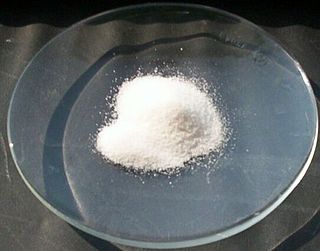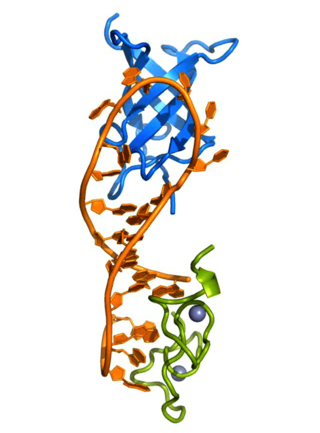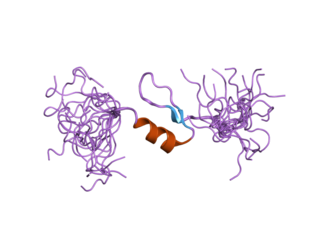Related Research Articles

Arsenic poisoning is a medical condition that occurs due to elevated levels of arsenic in the body. If arsenic poisoning occurs over a brief period of time, symptoms may include vomiting, abdominal pain, encephalopathy, and watery diarrhea that contains blood. Long-term exposure can result in thickening of the skin, darker skin, abdominal pain, diarrhea, heart disease, numbness, and cancer.
Transdifferentiation, also known as lineage reprogramming, is the process in which one mature somatic cell is transformed into another mature somatic cell without undergoing an intermediate pluripotent state or progenitor cell type. It is a type of metaplasia, which includes all cell fate switches, including the interconversion of stem cells. Current uses of transdifferentiation include disease modeling and drug discovery and in the future may include gene therapy and regenerative medicine. The term 'transdifferentiation' was originally coined by Selman and Kafatos in 1974 to describe a change in cell properties as cuticle producing cells became salt-secreting cells in silk moths undergoing metamorphosis.

Leptin is a protein hormone predominantly made by adipocytes and its primary role is likely to regulate long-term energy balance.

Adipose tissue (also known as body fat, or simply fat) is a loose connective tissue composed mostly of adipocytes. In addition to adipocytes, adipose tissue contains the stromal vascular fraction(SVF) of cells including preadipocytes, fibroblasts, vascular endothelial cells and a variety of immune cells such as adipose tissue macrophages. Adipose tissue is derived from preadipocytes. Its main role is to store energy in the form of lipids, although it also cushions and insulates the body. Far from being hormonally inert, adipose tissue has, in recent years, been recognized as a major endocrine organ, as it produces hormones such as leptin, estrogen, resistin, and cytokines (especially TNFα). In obesity, adipose tissue is also implicated in the chronic release of pro-inflammatory markers known as adipokines, which are responsible for the development of metabolic syndrome, a constellation of diseases, including type 2 diabetes, cardiovascular disease and atherosclerosis. The two types of adipose tissue are white adipose tissue (WAT), which stores energy, and brown adipose tissue (BAT), which generates body heat. The formation of adipose tissue appears to be controlled in part by the adipose gene. Adipose tissue – more specifically brown adipose tissue – was first identified by the Swiss naturalist Conrad Gessner in 1551.

Amylin, or islet amyloid polypeptide (IAPP), is a 37-residue peptide hormone. It is co-secreted with insulin from the pancreatic β-cells in the ratio of approximately 100:1 (insulin:amylin). Amylin plays a role in glycemic regulation by slowing gastric emptying and promoting satiety, thereby preventing post-prandial spikes in blood glucose levels.

Arsenic trioxide, sold under the brand name Trisenox among others, is an inorganic compound with the formula As
2O
3. As an industrial chemical, its major uses include the manufacture of wood preservatives, pesticides, and glass. It is also used as a medication to treat a type of cancer known as acute promyelocytic leukemia. For this use it is given by injection into a vein.

Streptozotocin or streptozocin (STZ) is a naturally occurring alkylating antineoplastic agent that is particularly toxic to the insulin-producing beta cells of the pancreas in mammals. It is used in medicine for treating certain cancers of the islets of Langerhans and used in medical research to produce an animal model for hyperglycemia and Alzheimer's in a large dose, as well as type 2 diabetes or type 1 diabetes with multiple low doses.

The bile acid receptor (BAR), also known as farnesoid X receptor (FXR) or NR1H4, is a nuclear receptor that is encoded by the NR1H4 gene in humans.

Chlorophyllin refers to any one of a group of closely related water-soluble salts that are semi-synthetic derivatives of chlorophyll, differing in the identity of the cations associated with the anion. Its most common form is a sodium/copper derivative used as a food additive and in alternative medicine. As a food coloring agent, copper complex chlorophyllin is known as natural green 3 and has the E number E141.
Leukotriene B4 (LTB4) is a leukotriene involved in inflammation. It has been shown to promote insulin resistance in obese mice.

Induced pluripotent stem cells are a type of pluripotent stem cell that can be generated directly from a somatic cell. The iPSC technology was pioneered by Shinya Yamanaka and Kazutoshi Takahashi in Kyoto, Japan, who together showed in 2006 that the introduction of four specific genes, collectively known as Yamanaka factors, encoding transcription factors could convert somatic cells into pluripotent stem cells. Shinya Yamanaka was awarded the 2012 Nobel Prize along with Sir John Gurdon "for the discovery that mature cells can be reprogrammed to become pluripotent."
In homeopathy, arsenicum album (Arsenic. alb.) is a solution prepared by diluting aqueous arsenic trioxide generally until there is little amounts of Arsenic remaining in individual doses. It is used by homeopaths to treat a range of symptoms that include digestive disorders and, as an application of the Law of Similars, has been suggested by homeopathy as a treatment for arsenic poisoning. Since the arsenic oxide in a homeopathic preparation is normally non-existent, it is considered generally safe, although cases of arsenic poisoning from poorly prepared homeopathic treatments sold in India have been reported. When properly prepared, however, the extreme dilutions, typically to at least 1 in 1024, or 12C in homeopathic notation, mean that a pill would not contain even a molecule of the original arsenic used. While Anisur Khuda-Bukhsh's unblinded studies have claimed an effect on reducing arsenic toxicity, they do not recommend its large-scale use, and studies of homeopathic remedies have been shown to generally have problems that prevent them from being considered unambiguous evidence. There is no known mechanism for how arsenicum album could remove arsenic from a body, and there is insufficient evidence for it to be considered effective medicine (for any condition) by the scientific community.

Transient receptor potential cation channel subfamily M member 5 (TRPM5), also known as long transient receptor potential channel 5 is a protein that in humans is encoded by the TRPM5 gene.

SHC-transforming protein 1 is a protein that in humans is encoded by the SHC1 gene. SHC has been found to be important in the regulation of apoptosis and drug resistance in mammalian cells.

Suppressor of cytokine signaling 2 is a protein that in humans is encoded by the SOCS2 gene.

Nuclear factor erythroid 2-related factor 1 (Nrf1) also known as nuclear factor erythroid-2-like 1 (NFE2L1) is a protein that in humans is encoded by the NFE2L1 gene. Since NFE2L1 is referred to as Nrf1, it is often confused with nuclear respiratory factor 1 (Nrf1).

Lin-28 homolog A is a protein that in humans is encoded by the LIN28 gene.

Forkhead box protein O1 (FOXO1), also known as forkhead in rhabdomyosarcoma (FKHR), is a protein that in humans is encoded by the FOXO1 gene. FOXO1 is a transcription factor that plays important roles in regulation of gluconeogenesis and glycogenolysis by insulin signaling, and is also central to the decision for a preadipocyte to commit to adipogenesis. It is primarily regulated through phosphorylation on multiple residues; its transcriptional activity is dependent on its phosphorylation state.

Krüppel-like factor 15 is a protein that in humans is encoded by the KLF15 gene in the Krüppel-like factor family. Its former designation KKLF stands for kidney-enriched Krüppel-like factor.
Kumaravel Somasundaram is an Indian cancer biologist and a professor at the Department of Microbiology and Cell Biology of the Indian Institute of Science. Known for his studies on the therapeutics of Glioblastoma, Somasunderam is an elected fellow of all the three major Indian science academies namely, the National Academy of Sciences, India, the Indian Academy of Sciences and the Indian National Science Academy. The Department of Biotechnology of the Government of India awarded him the National Bioscience Award for Career Development, one of the highest Indian science awards, for his contributions to biosciences in 2006.
References
- ↑ "Faculty". University of Kalyani. Retrieved 27 July 2015.
- ↑ Mukherjee, Dalia (5 April 2013). "World TB Day". The Telegraph. Archived from the original on 8 June 2013. Retrieved 27 July 2015.
- ↑ Rao, Menaka (12 June 2015). "After being rubbished by recent Australian study, beleaguered homeopaths look for credibility". Scroll.in. Retrieved 3 September 2015.
- ↑ Mallick, P; Chakrabarti Mallick, J; Guha, B; Khuda-Bukhsh, AR (2003). "Ameliorating effect of microdoses of a potentized homeopathic drug, Arsenicum Album, on arsenic-induced toxicity in mice". BMC Complementary and Alternative Medicine. 3 (1): 7. doi: 10.1186/1472-6882-3-7 . PMC 521186 . PMID 14570596.
- ↑ Bhattacharya, Shaoni (22 October 2003). "Homeopathy reduces arsenic poisoning in mice". New Scientist. Retrieved 21 October 2016.
- ↑ Das, Biplab (4 March 2013). "New antidote to diabetic arsenic victims". Nature Asia. doi:10.1038/nindia.2013.31 . Retrieved 12 June 2016.
- ↑ Das, Biplab (23 November 2015). "Homeopathic drugs modify gene expression in cancer cells". Nature Asia. doi:10.1038/nindia.2015.154 . Retrieved 27 December 2017.